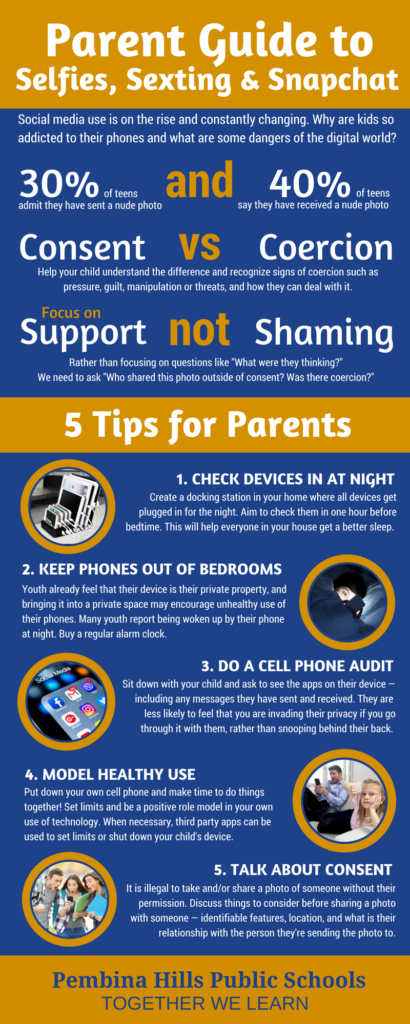Social media and technology use is on the rise and constantly changing. Unhealthy use of technology can lead to addiction, bullying and other problems. So what can parents do to understand the dangers and help support their child?
Colleen Teske, PHPS Coordinator of School Counseling, presented Growing up with Selfies, Sexting and Snapchat in several communities and schools during the past few months. The sessions focused on informing parents about the complex digital world, the dangers that exist, how parents can support their children and help create healthy boundaries for technology use. Here are some of those key messages.
Safe Sexting
According to the Canadian non-profit organization MediaSmarts, 30% of teens admit they have sent a nude photo, and 40% of teens say they have received a nude photo. We recognize that more and more teens are “sexting” or sharing nude photos — they justify it by saying it’s a safer alternative to physical contact. Just as we teach safe sex, we need to teach safe sexting.
Consent vs. Coercion
It’s very important to understand the difference between consent and coercion — and recognize the signs of coercion such as manipulation, guilt or threats, and how to deal with it.
Focus on Support not Shaming
Instead of focussing on questions like “What were they thinking?”, we need to ask, “Who shared this photo outside of consent, and was there coercion?” It can make a tremendous difference in the outcome of the situation.

What can parents do?
- Check devices in at night – Create a docking station in your home where all devices get plugged in for the night. Aim to check them in one hour before bedtime. This will help everyone in your house get a better sleep.
- Keep phones out of bedrooms – Youth already feel that their device is their private property, and bringing it into a private space may encourage unhealthy use of their phones. Many youth also report being woken up by their phone at night. Buy a regular alarm clock.
- Do a cell phone audit with your child – Sit down with your child and ask to see the apps on their device — including any messages they have sent and received. They are less likely to feel that you are invading their privacy if you go through it with them, rather than snooping behind their back.
- Model healthy use – Put down your own cell phone and make time to do things together! Set limits and be a positive role model in your own use of technology. When necessary, third party apps can be used to set limits or shut down your child’s device.
- Talk about consent – It is illegal to take and/or share a photo of someone without their permission. Discuss things they should consider before sharing a photo with someone — identifiable features, location, and their relationship with the person they’re sending the photo to.
Here are some additional resources that may be helpful.
- Ask the Mediatrician – Dr. Michael Rich, Pediatrician
- Common Sense Media
- MediaSmarts

